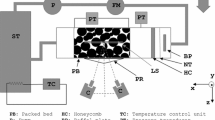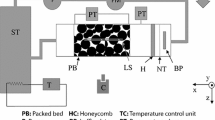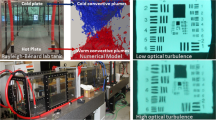Abstract
The flow fields for a sphere sedimenting through a Newtonian and two non-Newtonian liquids near a wall in a square tank are investigated using 3-D stereoscopic particle image velocimetry (PIV) and line integral convolution (LIC) methods. The PIV data were taken using an angular stereoscopic configuration with tilt and shift arrangements for the Scheimpflug condition and a pair of liquid correction prisms. Data were recorded from planes perpendicular and parallel to the wall for each fluid case over a range of distances from the wall. The PIV and LIC results highlight significant differences in the wake structure for all three cases. Out of plane flow was also found to persist up to two sphere diameters downstream in the wake for all cases.
Similar content being viewed by others
References
Adrian, R. J., Particle-imaging techniques for experimental fluid-mechanics, Ann. Rev. Fluid Mech., 23 (1991), 261–304.
Arigo, M. T. and McKinley, G. H., An experimental investigation of negative wakes behind spheres settling in a shear-thinning viscoelastic fluid, Rheologica Acta, 37 (1998), 307–327.
Becker, L. E., McKinley, G. H. and Stone, H. A., Sedimentation of a sphere near a plane wall: weak non-Newtonian and inertial effects, J. of Non-Newtonian Fluid Mech., 63 (1996), 201–233.
Bush, M. B., The stagnation flow behind a sphere, J. of Non-Newtonian Fluid Mech., 49 (1993), 103–122.
Bush, M. B., On the stagnation flow behind a sphere in a shear-thinning viscoelastic liquid, J. of Non-Newtonian Fluid Mech., 55 (1994), 229–247.
Cabral, B. and Leedom, L. C., Imaging Vector Fields Using Line Integral Convolution, Computer Graphics (SIGGRAPH ’93 Proceedings), J. T. Kajiya, Ed., 27 (1993–8), 263–272.
Chhabra, R. P., Uhlherr, P. H. T. and Boger, D. V., The influence of fluid elasticity on the drag coefficient for creeping flow around a sphere, J. of Non-Newtonian Fluid Mech, 6 (1980), 187–199.
Chmielowski, C., Nichols, K. L. and Jayaraman, K., A comparison of the drag coefficients of spheres translating in corn-syrup-based and polybutene-based Boger fluids, J. of Non-Newtonian Fluid Mech., 35 (1990), 37–49.
Harrison, G. M., Lawson, N. J. and Boger, D. V., The measurement of the flow around a sphere settling in a rectangular box using 3-dimensional particle image velocimetry, Chem. Eng. Comm., 188 (2001), 143–178.
Hassager, O., Working group on numerical techniques, J. of Non-Newtonian Fluid Mech., 29 (1988), 2–5.
Joseph, D. D., Liu, Y. J., Poletto, M. and Feng, J., Aggregation and dispersion of spheres falling in viscoelastic liquids, J. of Non-Newtonian Fluid Mech., 54 (1994), 45–86.
Kim, K. C., Lee, M. B., Yoon S. Y., Boo J. S. and Chun, H. H., Phase Averaged Velocity Field in the Near Wake of a Square Cylinder Obtained by a PIV Method, Journal of Visualisation, 5-1 (2002), 29–36.
Lawson, N. J. and Wu, J., Three-dimensional particle image velocimetry: experimental error analysis of a digital angular stereoscopic system, Meas Sci. Tech., 8 (1997), 1455–1464.
Longmire, E. K., Ganapathisubramani, B., Marusic, I., Urness, T. and Interrante, V., Effective visualization of stereo particle image velocimetry vector fields of a turbulent boundary layer, J. of Turb., 4 (2003), 023.
Mena, B., Manero, O. and Leal, L. G., The influence of rheological properties on the slow flow past spheres, J. of Non-Newtonian Fluid Mech., 26 (1987), 247–275.
Okada, A. and Kao, D. L., Enhanced Line Integral Convolution with Flow Feature Detection, Proceedings of IS & T/SPIE Electronics Imaging 97 (San Jose, California), v3017 (1997–2), 206- 217.
Prasad, A. K., Stereoscopic Particle Image Velocimetry, Exp. in Fluids, 29-2 (2000), 103–116.
Prasad A. K. and Jensen, K., Scheimpflug stereocamera for particle image velocimetry in liquid flows, Applied Optics, 34-30 (1995), 7092–7099.
Sigli, D. and Coutanceau, M., Effect of finite boundaries on the slow laminar isothermal flow of a viscoelastic fluid around a spherical obstacle, J. of Non-Newtonian Fluid Mech., 2 (1977), 1–21.
Singh, P. and Joseph, D. D., Sedimentation of a sphere near a vertical wall in an Oldroyd-B fluid, J. of Non-Newtonian Fluid Mech., 94 (2000), 179–203.
Stalling, D. and Hege, H..-C., Fast and Resolution Independent Line Integral Convolution, Computer Graphics (SIGGRAPH ’95 Proceedings), R. Cook, Ed., (1995), 249–256.
Tanner, R. I., End effects in falling-ball viscometer, J. of Fluid Mech., 17 (1963), 161–170.
Tatum J. A., Finnis M. V., Lawson, N. J. and Harrison, G. M., 3-D Particle Image Velocimetry of the Flow Field Around a Sphere Sedimenting Near a Wall. Part 1. Effects of Weissenberg Number, submitted to J. of Non-Newtonian Fluid Mech, (2004-3).
Yu-Cheong, I., Kobayashi, T., Saga, T. and Itoh, T., Stereoscopic PIV Measurements of Flow in and around Axial Flow Fan, Journal of Visualisation, 5-1 (2002), 51–58.
Author information
Authors and Affiliations
Corresponding author
Additional information
Nicholas J. Lawson: He received his Ph.D. in Mechanical engineering in 1995 from Loughborough University. After completing a post-doctoral assignment at the University of Melbourne, he joined the Department of Aerospace, Power and Sensors at Cranfield University in 1999 as a Lecturer before moving to the Department of Aerospace Sciences as a Senior lecturer in 2003. His research interests are the application and development of particle image velocimetry (PIV) and laser Doppler anemometry LDA techniques.
Mark V. Finnis: He received his Ph.D. in 1993 from Cranfield Institute of Technology. He works in the Department of Aerospace, Power and Sensors at the Royal Military College of Science, Cranfield University. His research interests are boundary-layer stability, wind-tunnel technology and external ballistics. He also has experience of wind tunnel flow measurement using PIV and LDA techniques.
Jared A. Tatum: He is a Ph.D. Candidate in the department of Chemical Engineering at Clemson University in Clemson South Carolina. Mr. Tatum received a BS with a double major in Chemical Engineering and Chemistry from Rose-Hulman Institute of Technology before beginning his Ph.D. candidacy. His research interests include: rheology of complex fluids, extensional properties of complex fluids, and optical techniques for complex fluid.
Graham M. Harrison: He received his Ph.D. in Chemical Engineering in 1997 from the University of California, Santa Barbara. After completing a post-doctoral assignment at the University of Melbourne, he joined the Dept. of Chemical Engineering at Clemson University in 1999 as an assistant professor. His research interests are Extensional Flow Properties and Optical Techniques for Non-Newtonian fluid mechanics.
Rights and permissions
About this article
Cite this article
Lawson, N.J., Finnis, M.V., Tatum, J.A. et al. Combined stereoscopic particle image velocimetry and line integral convolution methods. J Vis 8, 261–268 (2005). https://doi.org/10.1007/BF03181504
Received:
Revised:
Issue Date:
DOI: https://doi.org/10.1007/BF03181504




